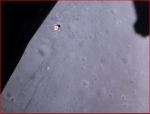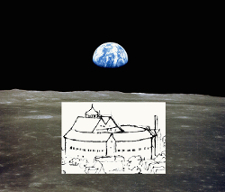Poetry of Arechi. Ryuichi Tamura.
Vanishing…. October 12, 2000
For Japan and its writers, the modern darkness deepens during the period of military fascism and World War II. With the defeat and unconditional surrender, immense shock waves rocked the entire culture calling into question the pseudo-Shinto and Confucian values Japan had based its society on for almost a century. As writers returned from one front or another of the war, they found a Japan devastated by the Allied bombing. Maebashi, for instance, where I lived for a few years, was reduced to rubble along with its bridges. Before long, the entire country was restructured by the Occupation. Japanese writers now understood much more deeply the experience of the Western World War I generation. Better than any other postwar poet, Tamura Ryuichi (1923-1998) registers, since his own hometown in the suburbs of Tokyo no longer existed, the shock and disorientation of the modern Japanese psyche. Briefly a student of Hagiwara Sakutaro, Tamura had little interest in classical Japanese poetry, which emphasized the unity of man and nature, but read widely in Western literature and was especially influenced by T. S. Eliot, Steven Spender, C. Day Lewis, and W. H. Auden, the last of whom Tamura eventually met in New York in 1971. In a literary magazine called Arechi or “wasteland,” Tamura and other postwar poets gave voice to the despair and horror they felt, unequivocally stating, in an early manifesto, “The present is a wasteland.” The first poem in which Tamura finds his true voice and distance from his material is the prose poem “Etching,” published in 1956:
Now he sees a landscape he saw in a German etching it appears to be an aerial view of an ancient city between twilight and darkness or a realistic drawing of a modern-day cliff being taken from midnight toward dawn This man the one I began to describe killed his father when he was young that autumn his mother went beautifully insane (tr. Christopher Drake)
The critic Ikuko Atsumi has said of this poem that it aims at a universal vision of East and West, ancient and modern. The extreme nationalism of the Japanese fascists now defeated, the “he” can view the fullness or “landscape” of Western culture, specifically German, declining into “darkness” or rising as “a modern-day cliff,” ominous, dehumanized, marked by loss and angst. Atsumi suggests the father “possibly refers to the emperor system in Japan, and the mother he made beautifully insane to Japan’s aesthetic consciousness.” Like the West, the East too descended into a wasteland of madness and violence, the ancient now discredited and rendered nugatory. This is the “Etching” come to light, etched into Tamura’s consciousness and all postwar Japanese writers of worth. Blending together the perspective of the subjective “I” and objective “he,” aware of the horror, Tamura introduces into Japanese poetry a voice of detachment, observing life outside his own personal existence with meditative restraint, seeking a deeper understanding of modern human experience.
Having known and read Tamura’s work for more than fifteen years, I have often thought of him as akin somehow to Robert Lowell. He has a memory of Japan’s past that he never idealizes, but works with and probes it, pondering always without sentimentality the modern and by-gone days. Like Lowell and so many postmodern Western poets, Tamura also goes through a time of fairly formalistic writing, but he seems to outgrow it and returns to engaging universal experience outside his own little personal consciousness. Many other Japanese poets, as in the United States, are still stuck in such solipsism. Saigyo and Basho both believed poetry must consider the transcendent and involve conceptual knowledge outside the self, not merely aesthetic formalism. As late as 1982, in what is one of his greatest poems, “Spiral Cliff,” Tamura looks soberly at modern world history. After the speaker reflects on a photograph of a deer “falling off a cliff” and wonders “what’s after it,” he says,
Our century ends without decadence/ after the night and fog of Nazi gas chambers/ after Soviet forced labor camps/ after two U.S. atomic bombs on Japan/ there’s no thrill left in killing,/ no fear of the soul, no crime in adultery. . . .
In “our century,” the values requisite for perceiving and defining “decadence” have disappeared, “crime and evil disconnected,” all restraining sense of the soul lost. As a result, unimaginable horror has been perpetrated in every region of the globe on an appalling scale affecting both the social and individual realms. Like a roller coaster, “our century ends on pure speed.” Recalling the photo of the deer, he thinks,
I’m afraid of high places/ the cliff in me/ am I the hunter/ or the prey?
The “high places” are both those of earlier mentioned “boardrooms / of huge corporations,” East and West, in a manner reminiscent of Kaneko Mitsuharu’s Book of Mud, and the “modern-day cliff” of confusion, now “the cliff in me.” The ambiguity of the question “am I the hunter / or the prey?” acknowledges the complexity of modern life where all are somehow complicitous in human tragedy. Terrified by “blank paper,” by “what dreams will live and die there,” Tamura accepts the writer’s obligation to struggle for values worthy of all human beings, not just Japanese.
Next in dream half nightmare, he sees his own inner cliff protruding “between dreams / spiraling” down. Waking in the dawn, lying horizontally across the bed, he reads the morning newspaper full of massacre and civil war:
Vanishing/ cliff dream/ vertical dream/ elementally/ Gone
All the dreams have vanished as off the edge of a cliff. Vertical dreams have been replaced by the horizontal, exactly the information that fills the newspaper. Like the best of modern writers, W. H. Auden or Robert Lowell, Tamura has the honesty and strength of intellect and spirit to recognize it is all “gone.” I believe his vision of modern life and Japan is true, for it has been my own experience, lived not only in Japan but also in the United States, where “without decadence” the culture sinks to ever more dehumanized levels of violence, depravity, and social fragmentation. The importance of Ryuichi Tamura’s poetry has not been sufficiently recognized in the West, nor in Japan.




